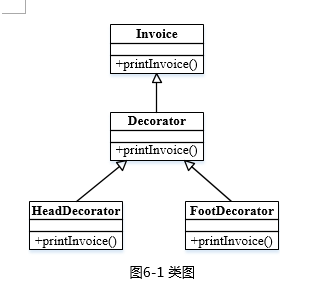ticket sales only make( )30% of their income.A. upB.--C. inD. to
题目
A. up
B.--
C. in
D. to
相似考题
更多“ticket sales only make( )30% of their income. ”相关问题
-
第1题:
Ticket ________ should use Gates 7 and 8.A.holding
B.held
C.holders
D.holder
正确答案:C
-
第2题:
阅读下列说明和Java代码,将应填入(n)处的字句写在答题纸的对应栏内。 【说明】 某发票(lnvoice)由抬头(Head)部分、正文部分和脚注(Foot)部分构成。现采用装饰(Decorator)模式实现打印发票的功能,得到如图6-1所示的类图。
【java代码】 class invoice{ public void printInvoice(){: System.out.println("This is the content of the invoice!"); } } class Decorator:extends Invoice{ protected Invoice ticket; public Decorator(lnvoice t){ ticket=t; } public void printinvoice(){ if(ticket!=NULL) (1); } } class FootDecorator extends Decorator{ public FootDecorator(lnvoice t){ super(t); } public void printinvoice(){ Systent.out.println("This is the header of the invoice!"); (2); } } class FootDecorator extends Decorator{ public FootDecorator(invoice t):{ super(t); } public void printlnvoice(){ (3); Systent.out.println("This is the header of the invoice!"); } } Class test{ public static void main(string[]args){ Invoice t=new invioce(); Invoice ticket; Ticket=(4); Ticket.Printinvoice(); Systent.out.println(“--------------“) Ticket=(5); Ticket.Printinvoice(); } } 程序的输出结果为: This is the header of the invoice! This is the content of the invoice! This is the footnote of the invoice! ---------------------------- This is the header of the invoice! This is the footnote of the invoice!答案:解析:(1) ticket.printInvoice() (2) ticket.printInvoice() (3) ticket.printInvoice() (4) new FootDecorator(new HeadDecorator(t)) (5) new FootDecorator(new HeadDecorator(new Decorator(null)))
【解析】
试题分析
本题考查的是面向对象程序设计和设计模式。本题涉及的设计模式是装饰模式。装饰模式(Decorator) :动态地给一个对象添加一些额外的职责。它提供了用子类打展功能的一个灵活的替代,比派生一个子类更加灵活。
对于程序填空可以参照代码上下文、题干说明和设计模式综合考虑。
对于第(1) 空,是对printInvoice方法的具体调用,在Decorator是 装饰类,继承了Invoice发票类。此处需要填写的是printInvoice方法的方法体,根据Decorator类的上下文,已定义ticket对象,所以此处调用printinvoice方法的是ticket,第(1) 空填写ticket printlnvoice()。
对于第(2) (3) 空,根据类图可知,分别是HeadDecorator抬头 类、FootDecorator脚注类调用printInvoice方法的方法体,由于在这两个类中并没有定义属性,只有借助其超类的构造函数,所以这两个地方调用printlnvoice方法的是它们的超类,即(2) (3) 填写的是super.printInvoice()。
对于第(4) (5) 空,考查的是对装饰模式的调用,都是main函数中实例化的过程,根据输出结果可以看到,第(4)空实例化ticket对象,可以输出抬头、内容、脚注3个部分, 因此需要调用三者的printInvoice()方法, 前面已经实例化了一个Invoice对象t,可以利用给子类实例化,因此第(4) 空填写new HeadDecorator(new FootDecorator());而第(5)空没有输出具体内容,只有抬头和脚注部分,可以看到这里的Invoice对象应该是空,所以第(5) 空填写new HeadDecorator(new FootDecorator(nl)。 -
第3题:
阅读下列说明和java代码,将应填入 (n) 处的字句写在答题纸的对应栏内。
【说明】
某发票(lnvoice)由抬头(Head)部分、正文部分和脚注(Foot)部分构成。现采用装饰(Decorator)模式实现打印发票的功能,得到如图6-1所示的类图。
【java代码】
class invoice{
public void printInvoice( ){
System.out.println ( "This is the content of the invoice!");
}
}
class Decorator extends Invoice {
protected Invoice ticket;
public Decorator(lnvoice t){
ticket = t;
}
public
void printInvoice( ){
if(ticket != null)
(1) ;
}
}
class HeadDecorator extends Decorator{
public HeadDecorator(lnvoice t){
super(t);
}
public void printInvoice ( ){
Systent.out.println( "This is the header of the invoice! ");
(2) ;
}
}
class FootDecorator extends Decorator {
public FootDecorator(Invoice t){
super(t);
}
public void printlnvoice( ){
( 3) ;
Systent.out.println( "This is the footnote of the invoice! ");
}
}
Class test {
public static void main(String[] args){
Invoice t =new Invioce( );
Invoice ticket;
ticket= (4) ;
ticket.printInvoice( );
Systent.out.println(“------------------“);
ticket= (5) ;
ticket.printInvoice( );
}
}
程序的输出结果为:
This is the header of the invoice!
This is the content of the invoice!
This is the footnote of the invoice!
----------------------------
This is the header of the invoice!
This is the footnote of the invoice!答案:解析:(1) ticket.printInvoice()
(2) ticket.printInvoice()
(3) ticket.printInvoice()
(4) new FootDecorator(new -
第4题:
试题六(共15分)
阅读下列说明和Java代码,将应填入 (n) 处的字句写在答题纸的对应栏内。
【说明】
某发票(lnvoice)由抬头(Head)部分、正文部分和脚注(Foot)部分构成。现采用装饰( Decorator)模式实现打印发票的功能,得到如图6-1所示的类图。

【java代码】
class invoice{
public void printInvoice(){:
System.out.println ( "This is the content of the invoice!");
}
}
class Decorator : extends Invoice {
protected Invoice ticket;
public Decorator(lnvoice t){
ticket = t;
}
public void printinvoice(){
if(ticket != NULL)
(1);
}
}
class FootDecorator extends Decorator{
public FootDecorator(lnvoice t){
super(t);
}
public void printinvoice (){
Systent.out.println( "This is the header of the invoice! ");
(2) ;
}
}
class FootDecorator extends Decorator {
public FootDecorator(invoice t):{
super(t);
}
public void printlnvoice(){
(3) ;
Systent.out.println( "This is the header of the invoice! ");
}
}
Class test {
public static void main(string[] args){
Invoice t =new invioce();
Invoice ticket;
Ticket= (4) ;
Ticket. Printinvoice();
Systent.out.println(“--------------“)
Ticket= (5) ;
Ticket. Printinvoice();
}
}
程序的输出结果为:
This is the header of the invoice!
This is the content of the invoice!
This is the footnote of the invoice!
----------------------------
This is the header of the invoice!
This is the footnote of the invoice!
正确答案:
-
第5题:
请选出读音不同的选项。( )A.physics
B.quickly
C.library
D.ticket答案:C解析:暂无解析 -
第6题:
2010年,MAKE奖的全球级奖项细分为全球MAKE奖和全球独立运营机构MAKE奖。
正确
